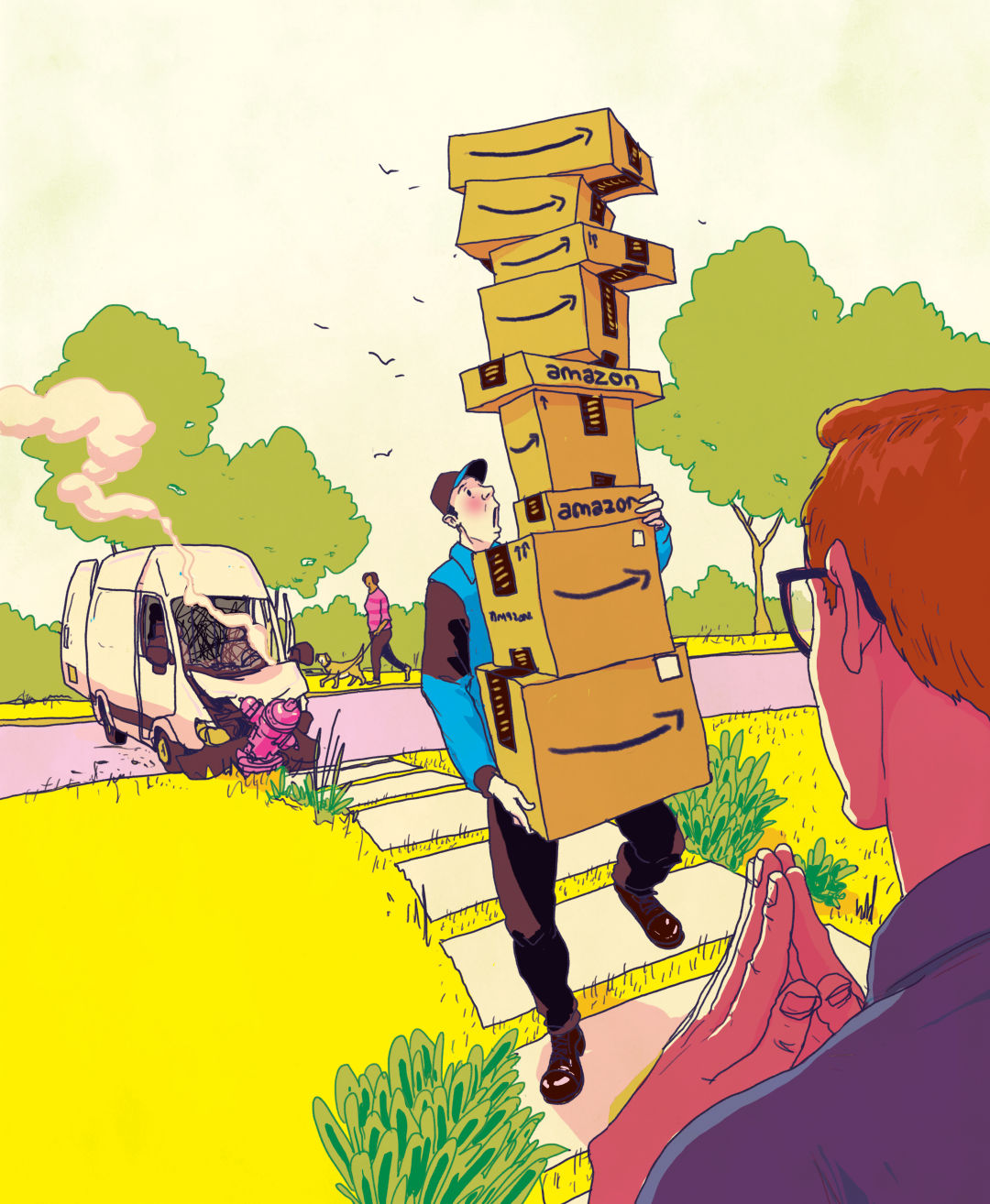The Hidden Cost and Human Toll of Amazon

Image: Michael Byers
Before that package you’re expecting comes to rest at your door, Freddie Carroll is up at 3am, behind the wheel of his Toyota Camry, headlights tunneling through the dark up I-5, from Seattle to the warehouse in Everett. There, he picks up the morning’s haul: padded plastic envelopes and cardboard boxes, all emblazoned with the telltale smile.
On his way to your doorstep, Carroll may catch an unkind glance from your neighbor. He’s had the police called on him. (“I am African American,” he says, “so I have those situations happen to me.”) And before the day is done, he might put 200 miles on the Camry. Because Freddie Carroll is Amazon’s favorite kind of person. A workaholic.
What he and tens of thousands of delivery drivers are not, in the company’s view at least, are Amazon employees. They work not for the Everything Store but with it, the company line goes, as independent contractors.
The program, Amazon Flex, is one of the ways the Seattle-based online retailer delivers merchandise hours after you tap the Buy Now button. There are costs, hidden from you and shifted off Amazon’s balance sheet. A ProPublica investigation last year found Amazon contract drivers had been involved in more than 60 serious crashes since 2015, the year Flex launched to fill gaps left by couriers like UPS, overwhelmed by the volume of packages. Beyond that, an increasing number of Flex drivers say that Amazon—paying a flat rate that doesn’t account for expenses—is shorting them. In lawsuits that have piled up since October 2016, the litigants claim they don’t make minimum wage and are denied basic worker protections because they aren’t classified as employees.
Like Uber, like Postmates, like much of the rest of the high-volume, low-headcount new economy, Amazon has placed workers like Carroll in a gray area of labor law. An area left murky by lawmakers to protect independent plumbers, stylists, and other entrepreneurs who set their own rates, solicit their own work, chart their own course, and choose their own risks. The company charged into that space with Flex, as well as a constellation of franchises that lease liveried vans from Amazon and pay Amazon-uniformed contractors to drive them.
Shannon Liss-Riordan, a Boston attorney, specializes in class action lawsuits against employers. Her client list now includes Carroll, who joined his wife and three other Amazon Flex drivers in a lawsuit demanding unpaid wages. The attorney aims to add thousands of other drivers to the lawsuit if a federal judge in Seattle certifies the suit—much slowed by appeals brought by Amazon—as a class action.
“So many companies have tried to argue that they’ve developed a whole new way of doing work that doesn’t require the workers to have any protections,” Liss-Riordan says. “That’s fundamentally wrong.”

Image: shutterstock by m.mphoto
Carroll prefers to start his day early. The unpopular time slots can pay better—as much as $91 for a four-hour shift, and more than Amazon’s standard per hour rate. Amazon’s advertised rates for Flex range from $18 to $25 an hour, and the company says drivers average $22 an hour before their costs. Carroll packs the car methodically; time spent digging for packages on the road is time wasted. In the hours that follow, he takes directions sent to his phone through the Flex app. If there are any leftovers after the shift for which he’s paid, he delivers them, sometimes pro bono. Amazon is watching, and will cut the father of three loose if he misses the company’s targets.
Overtime isn’t a thing for an independent contractor, nor is Seattle’s celebrated $15 hourly minimum wage. The paychecks Amazon cuts Carroll don’t count his hours, just his runs. If he slips on your stairs, he doesn’t get workers’ compensation. If the economy tanks and Amazon drops him, he won’t draw unemployment to smooth the bump.
Carroll and his fellow litigants see themselves as employees. Amazon takes pains to say they’re not. Attorneys for the company compare the Flex drivers to FedEx, UPS, and the U.S. Postal Service, which has also delivered Amazon orders for years. Drivers, being independent, have the ability to choose their work, Amazon says. Those who have sued do so, the company’s attorneys argue, “despite this freedom, flexibility, and control over virtually all that they do.”
Under the weight of the gig economy, changes to the law may be breaking through. The solution put forward is simple. Legislation floating around America’s statehouses, including in Olympia, would dictate that workers be presumed employees, unless an employer can show they aren’t. Workers like Carroll wouldn’t have to fight it out in court to get the rights afforded employees.
“Amazon, it’s big,” Carroll says. “All of us delivery drivers, we helped create the empire they’ve become. They should thank people more than they do.”
Editor's note: This article was updated on December 24, 2019, to include information from Amazon regarding the hourly rate paid to Flex drivers.




